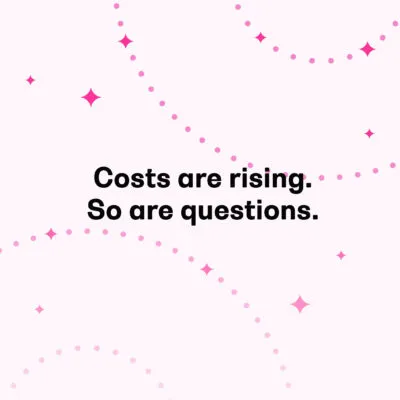Volvo has been producing witty and memorable ads since the early 60s. Drive It Like You Hate It features one of their popular compact models racing through rugged terrain. As the car twists, turns and drifts along an unkempt dirt road, the narrator lets the viewer know that Volvo gets 25 miles per gallon and can still outrace any popular compact car on the market.
After making a series of sharp turns, enduring a few bumps, and coming to an abrupt stop in front of an unexpecting cow, the commercial ends with, “And… you can drive a Volvo like you hate it. Cheaper than psychiatry.”
While the commercial has a funny and undeniably cool aura, it primarily focuses on functionality. It highlights the car’s speed, gas efficiency, durability, maneuverability, and brake quality. This is a textbook example of how to demonstrate the functionality of a product, and it’s a marketing strategy that’s been used for decades with great success. However, what we’re seeing more and more in recent years is a shift from functional to emotional marketing.
Below we’ll break down the functional and emotional benefits of marketing and how you can use both to communicate your value propositions effectively.
What are functional benefits?
So what are functional benefits? A product or service’s functional benefits include product/service attributes, capabilities, or features that demonstrate the utility of what you’re selling. It tells customers what the product does and how well it does it.
Functional benefits are best advertised when they highlight what you do best and why it’s better than what your competitors are doing. If you can’t define how your product or service differs from competitors, your marketing efforts will often feel limited if your only scope is functionality.
Examples of functional benefits
Some notable functional benefit examples from major companies include:
Also, as noted above, the durability and strength of padlocks in Master Lock’s historical ad.
While many gyms are open 24 hours a day, 24 Hour Fitness is the only gym that owns such a statement directly in their name.
Charles Barkley’s 1993 “I am not a role model” commercial sends an emotional message that was the antithesis of the “Like Mike” campaign. Still, its most prominent point highlights how Nike shoes can enable its customers to dominate the basketball court like Barkley.
Like George Foreman Grills or Bowflex, most infomercial products almost exclusively sell functionality. Like face creams or house cleaners, before-and-after ads are by design presented to show functionality.
What are emotional benefits?
Emotional benefits present consumer feelings when they commit to purchasing from a brand. They’re saying yes to the product or service, but they’re also saying yes to the brand, its mission statement, its marketing campaign, and its values.
Any organization that promises a portion of its sales to charity or a donation campaign also sells a more significant cause. When companies market their products as locally sourced or made, they’re selling the satisfaction customers get when they believe they’re helping keep the planet clean or supporting hard-working local businesses.
Enterprise businesses have started integrating narratives, tragic events, symbolism, and emotionally engaging content to elicit an emotional response from their viewers. Apple has showcased some of the most compelling emotional benefits marketing examples recently.
The “911 Emergency” Apple Watch Series 7 commercial shows how the Apple Watch saved three individuals from near-death scenarios. All three situations–an injured farmer, a woman stuck in a vehicle slowly filling with water, and a paddle boarder being swept out to sea–place the viewer directly into the scene.
The fear and sense of urgency in each voice immediately build that fear into the viewer, and it’s hard not to wonder how you would handle being in their situation.
A brief note about self-expressive benefits
Self-expressive benefits are also used to connect with a customer’s self-image and identity. For example, they tap into the cultural ethos of a demographic or target customer to show how a product aligns with a specific identity or way of life.
Some marketing efforts, like Gap’s “American Dream” commercial, use poetry, displays of various fashion styles, and a diverse set of models to underscore a sense of creativity and individuality within their brand.
The benefit here is allowing your customers to identify with a brand and feel the qualities in the product/service they would like to see in themselves.
When to lean on a functional vs. emotional benefit when marketing your brand
The marketing trends in 2022 are heavily leaning on emotional benefits and emotional targeting. Of course, the functionality still needs to be demonstrated, but emotions are more vivid and resonate stronger than isolated functional benefits.
Focusing on functional benefits
Still, there are ways to focus on functional benefits in your marketing campaigns effectively. For example, leaning on functional benefits in your ads is a good idea if:
You have a clear differentiator.
Sometimes, you need a clear and easy-to-express differentiator to win over a customer. If you have a coveted patent or strategic approach that is different from what anyone else is doing, showcase those advantages.
You still need to win over your customer.
It might be hard to sell an emotion if your customers don’t know what you do if you’re a new or emerging company. In this case, you don’t have the brand recognition or cultural presence that the major enterprises do. Of course, you can still use emotion in your ads and campaigns, but you should be prioritizing introducing who you are and what you do to consumers.
You have a new product, service, or way of doing things.
If you have a new product, service, or technology with an existing customer base, there will be a barrier to entry in educating your consumer. Therefore, kicking off a marketing campaign that is more educational or demonstrative is a good idea when you’re introducing a new feature, service, technology, or product.
Focusing on emotional benefits
As highlighted in some of the ads mentioned above, we’re seeing today an emphasis on eliciting a feeling or emotional response. Notice, however, that all of these ads still communicate the functional benefits of their products/services; they do it with an emotional anchor.
For brands today, the sweet middle-ground is to support your functionality with the proper emotional messaging. For example, later, Volvo ads relied on emotional messaging by tapping into consumers’ fears. Still, they also simultaneously appeased those fears by showing how their products can keep customers and their loved ones safe.
Functionality and emotional benefits complement one another. There’s a way to use emotional messaging to support functional benefits and vice versa. Companies that can turn this kind of marketing into an infrastructural approach will succeed most in their marketing and branding efforts.
Final thoughts on your company's value proposition to target customers
The real-life value of a product or service is only as valuable as your ability to communicate that value, so marketing and branding are so important. Utilizing functional, emotional, and expressive benefits in unison will give you the flexibility and creative freedom to communicate effectively with your target customers.
On the way to building your stellar marketing campaign, you will likely want to know if your marketing efforts were successful or not. But, more importantly, you will want to know where your brand and customer interests are headed in the future.
What do Burt’s Bees, PayPal, Crayola, AAA, Intel, and Amazon have in common? They put themselves out there in bold and engaging ways and let their customers know exactly who they are and what they represent. Keep reading.
About BERA
Our Predictive Brand Technology is powered by the world’s largest syndicated brand equity data stream that automates the real-time collection, analysis, and measurement of 100+ consumer-based metrics, across 4,000+ brands in 200+ sectors globally. With BERA, brands can discover which metrics determine their brand’s equity, see which audiences offer the best brand growth opportunities, and how to activate the right brand positioning strategy to make smarter brand decisions, grow financial outcomes, and drive Brand to Business™ impact.




